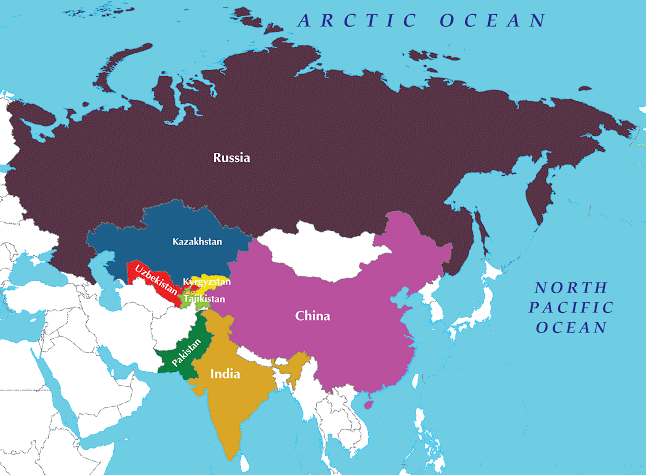CONTENTS
- Shanghai Cooperation Organization
- SVAMITVA
Shanghai Cooperation Organization
Focus: GS II: International Relations
Why in News?
Union Minister for Road Transport and Highways Shri Nitin Gadkari chaired the 10th Meeting for the Shanghai Cooperation Organization (SCO) Transport Ministers at New Delhi.
What is the SCO?
- Founded in June 2001, it was built on the ‘Shanghai Five’, the grouping which consisted of Russia, China, Kazakhstan, Kyrgyzstan and Tajikistan.
- They came together in the post-Soviet era in 1996, in order to work on regional security, reduction of border troops and terrorism.
- They endowed particular focus on ‘conflict resolution’, given its early success between China and Russia, and then within the Central Asian Republics.
- Some of their prominent outcomes in this arena entail an ‘Agreement on Confidence-Building in the Military Field Along the Border Areas’ (in 1996) between China, Russia, Kazakhstan, Kyrgyzstan and Tajikistan, which led to an agreement on the mutual reduction of military forces on their common borders in 1997.
- It would also pitch in to help the Central Asian countries resolve some of their boundary disputes.
- In 2001, the ‘Shanghai Five’ inducted Uzbekistan into its fold and named it the SCO, outlining its principles in a charter that promoted what was called the “Shanghai spirit” of cooperation.
- The precise assertion, combined with some of the member states’ profiles, of building a “new international political and economic order” has often led to it being placed as a counter to treaties and groupings of the West, particularly North Atlantic Treaty Organisation (NATO).
Member states

- India, Kazakhstan, China, Kyrgyzstan, Pakistan, Russia, Tajikistan and Uzbekistan.
- The SCO also has four observer states — Afghanistan, Iran, Belarus and Mongolia — of which Iran and Belarus are now moving towards full membership.
Main goals
- Strengthening mutual trust and neighbourliness among the member states;
- Promoting their effective cooperation in politics, trade, economy, research and technology, and culture.
Focus areas:
- Education, energy, transport, tourism and environmental protection.
- It also calls for joint efforts to maintain and ensure peace, security and stability in the region; and the establishment of a democratic, fair and rational new international political and economic order.
Organizational structure of SCO
The SCO secretariat has two permanent bodies —
- SCO Secretariat based in Beijing
- Executive Committee of the Regional Anti-Terrorist Structure (RATS) based in Tashkent.
Other than this, the grouping consists of
Heads of State Council (HSC):
- It is the supreme decision-making body of the organisation.
- It meets annually to adopt decisions and guidelines on all important matters relevant to the organisation.
Heads of Government Council (HGC):
- The HGC (mainly including Prime Ministers) also meets annually to zero in on the organisation’s priority areas and multilateral cooperation strategy.
- It also endeavours to resolve present economic and cooperation issues alongside approving the organisation’s annual budget.
Foreign Ministers Council:
- The Foreign Ministers Council considers issues pertaining to the day-to-day activities of the organisation, charting HSC meetings and consultations on international problems within the organisation and if required, makes statements on behalf of the SCO.
About SVAMITVA
Focus: Government Policies and Interventions
Why in News?
Recently, the Uttar Pradesh state government completed the distribution of 55,14,921 ‘gharaunis’ (rural house records) under the Svamitva scheme.
About SVAMITVA
- SVAMITVA (Survey of Villages and Mapping with Improvised Technology in Village Areas) scheme is a collaborative effort of the Ministry of Panchayati Raj, State Panchayati Raj Departments, State Revenue Departments and Survey of India.
- Aim: To provide an integrated property validation solution for rural India.
- It is a scheme for mapping the land parcels in rural inhabited areas using drone technology and Continuously Operating Reference Station (CORS).
- The mapping will be done across the country in a phase-wise manner over a period of four years – from 2020 to 2024.
Beneits:
- The scheme will help in streamlining planning and revenue collection in rural areas and ensuring clarity on property rights.
- The scheme will enable creation of better-quality Gram Panchayat Development Plans (GPDPs), using the maps created under this programme.
- The Gram Panchayats are constitutionally mandated for preparation of Gram Panchayat Development Plans (GPDP) for economic development and social justice.
- The GPDP is based on a participatory process in convergence with schemes of all related Central Ministries/Line Departments related to 29 subjects listed in the Eleventh Schedule of the Constitution.
- Present Coverage Area: The program is currently being implemented in six states – Haryana, Karnataka, Madhya Pradesh, Maharashtra, Uttar Pradesh and Uttarakhand.





